France; The Camargue in summer
June 2008, list with update July 2014
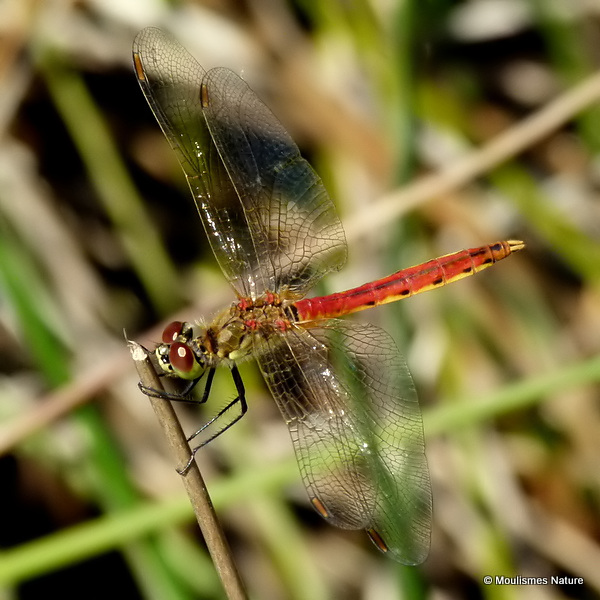
Spotted Darter (Sympetrum depressiusculum) male
France; Camargue in summer GALLERY
This report 14 - 21/6/2008. In July 2014 I co-lead a Birds/Dragonflies Camargue tour for Naturetrek. Those species have been added to the lists here, as the sites were much the same. The emphasis on that tour was obviously as much on birds as odonata.
Inspired by Jacquie Crozier’s book and research of websites covering nature reserves in the area (see Reference Sources), we decided to make base at a campsite near St-Martin-de-Crau. The Camargue is still one of the greatest wetlands in Western Europe, so a logical place to look for dragonflies and damselflies. In fact, we concentrated more on the Crau, an area with a growing reputation amongst odonata watchers, and did more birdwatching in the Camargue. We also visited the hills of Les Alpilles, north of La Crau, when too hot to walk the open areas.
In the varied habitats of the Camargue, the Crau and associated marshes, and Les Alpilles, 61+ species of odonata have been recorded.
The Camargue Regional Park south of Arles lies between the two arms of the Rhone as it forms a delta and enters the Mediterranean Sea. The Park covers 850 square kilometres and has the variety of habitats one would expect, including rice paddies and saltworks, saline, brackish and freshwater lagoons.
The Crau, with its’ unique stony desert landscape and bizarre weather, is well-known to birders because of the specialist breeding birds. The areas we visited here were all within 20 kilometres and to the south of St-Martin-de-Crau.
Les Alpilles are a chain of rugged limestone hills c28 kilometres long, covered in pine forest and garrigue, the highest point being just 493 metres.
We also checked areas local to our campsite at Mouries, nine kilometres north-east of St-Martin, mainly at points along the Canal de la Vallee des Baux, west of Mouries.
The weather was cool, 12-15 degrees and very wet for the first three days, quickly turning to a stifling 34+ degrees and dry for the remainder, this apparently being more normal for mid-June, but too hot to look for odonata by midday. The Camargues’ reputation for mosquitoes proved totally valid in wet weather, exceeding both in numbers and persistence anything we’ve encountered elsewhere in the world !
We made no attempt to see the specialist breeding birds of the Crau, the birds recorded were those seen whilst looking for odonata species; in the Camargue we did more birdwatching, depending on the weather or lack of dragonflies.
The timing here was at least a week too early for the maximum odonata species, particularly in a ‘late’ year – the last week in June would be good, after that the temperatures would be very hot, with more tourists and more traffic. The Camargue is a busy tourist area.
SITES VISITED
Peau de Meau Reserve, La Crau
Peau de Meau is well-known to birders looking for the Crau specialities. A permit is needed here, obtainable from Ecomusee de La Crau, on a corner in the main high street in St-Martin. Price at the time was 3 Euros per person for 2 days, proceeds going towards upkeep and improvement of the reserve. The trail and information boards have just been upgraded, and you get a map and info, in English, with the permit.
The Peau de Meau stream is the area of prime interest here for dragonfly watchers, it runs from the parking area in a straight line south-west towards the main highway N 568. Although it looks fairly mundane, the rich vegetation on the banks and below the water, and the purity and steady flow make for an abundance of odonata; around 50 species have been recorded here.
Etang des Aulnes, La Crau
Known to birders en route to Peau de Meau as a site of little interest, we saw few birds here either. About 1.5 kilometres south of La Dynamite and the junction with the D24, along the approach road to Peau de Meau, there is parking and an information board.
For dragonflies, we found the best area to be the course fishing zone, sign-posted on the road. Here there are three fishponds with a high density of odonata – we saw 15+ species in less than two hours.
Vigueirat Marshes, south of La Crau
A wetland reserve on the south-west side of La Crau, with a nice 2km trail through reedbeds, swamp forest and fields. The reserve centre is 2kms south-east of Mas Thibert, a few kms west of Peau de Meau, and is sign-posted from the town. Access to the core part of the marsh is by guided tour only, on a horse-drawn carriage ! We did the trail, but I suspect the best habitat is the central area.
Disappointing density of dragonflies seen, perhaps better after dryer conditions; a key site that we should have seen more at. Very good for mosquitoes…
Canal de la Vallee des Baux, north of La Crau
The Vallee des Baux lies between Les Alpilles to the north and La Crau to the south, with the canal running east-west along the valley. We checked road bridges over the canal, particularly the D33 and D27, both quite good for odonata, and found a ruined roman aqueduct south of Fontvieille on the D33 to be good also.
Parc Ornithologique, La Camargue
4 kilometres north of Saintes-Maries-de-la-Mer, the first part of the park is a bird hospital/recovery centre with victims of the ‘hunters’ guns, and the traffic, in large aviaries, mostly raptors and owls. After that there are good freshwater and brackish lagoons along a 7 kilometre trail. Probably good for dragonflies without the rain that we had.
Etang du Charnier and Etang de Scamandre, La Camargue
In the north-west Camargue, we looked at two freshwater etangs and the Sete canal. Route D779 runs NW – SE between the two etangs, and at the junction with D179 to the south there is a small reserve with trail and visitor centre. Along the south bank of the Sete canal is a drivable track giving views over Etang du Charnier. Good area for freshwater birds and some odonata species. The reserve looked good and deserved more time than we could give it.
We also drove down to the coast on routes D36 B, C and D, along the east side of the Etang de Vaccares and the Digue – all well-known birding sites amply covered by books and birding trip reports.
The Camargue has the largest Greater Flamingo population in Europe, c50,000 birds, and all the European herons breed there, the latest being Great White Egret. On the down side, this being France 150,000 ducks are shot each year….
Les Alpilles
La Caume is a communication station east of Les Baux, on the east side of route D5, where there is parking and the start of a track towards the summit. Well-known to birders looking for Bonelli's Eagle, etc, by the time of our visit there was no flowing water, so it produced little in the way of dragonflies.
REFERENCE SOURCES
A Birdwatching Guide to France South of the Loire. J. Crozier, Arlequin Press, 2000.
Vigueirat Marshes website
Conservatoire du littoral
Ecomusee de la Crau
Parc Ornithologique
Camargue Regional Park
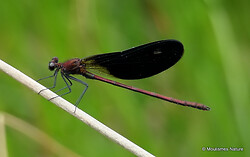
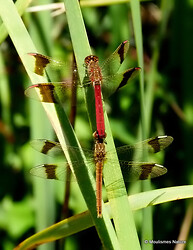
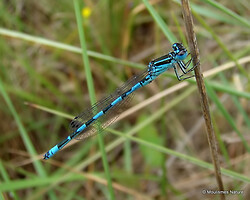
SPECIES RECORDED; DRAGONFLIES AND DAMSELFLIES
Main source of reference - Field Guide to the Dragonflies of Britain and Europe. Dijkstra/Lewington, BWP 2006.
30 species seen. A poor total, I believe 35+ is possible even in mid-June, although probably too early for Orange-spotted Emerald Oxygastra curtisii, or Dusk Hawker Boyeria irene, definitely too early for Banded Darter Sympetrum pedemontanum (all three seen July 2014). The migratory Vagrant Emperor Anax ephippiger is described by Dijkstra as ‘uncommon, scattered and/or irregular’ throughout the Mediterranean.
Worst ‘miss’ was Yellow-tailed Demoiselle Calopteryx xanthostoma at Peau de Meau, a site known for holding all the European demoiselles. Dijkstra states that this species replaces C. splendens in southern France, we found and photographed only C. splendens.
The variety of blue damselfly species seen, two, was disappointing, and Scarce Blue-tailed Ischnura pumilio, must be here somewhere. Perhaps more time should have been spent at Etang des Aulnes
Total (both trips) = 36. Extra species July 2014 added in blue
BANDED DEMOISELLE Calopteryx splendens – Peau de Meau, Vallee des Baux, etc
BEAUTIFUL DEMOISELLE Calopteryx virgo – Peau de Meau only
COPPER DEMOISELLE Calopteryx haemorrhoidalis – Peau de Meau only
WILLOW EMERALD Lestes veridis – Etang des Aulnes
WINTER DAMSELFLY Sympecma fusca – Vigueirat marshes, Etang des Aulnes
BLUE-TAILED DAMSELFLY Ischnura elegans – recorded throughout
AZURE DAMSELFLY Coenagrion puella – Vigueirat marshes
SOUTHERN DAMSELFLY Coenagrion mercuriale – Peau de Meau, the only ‘blue’ found there
SMALL RED-EYED DAMSELFLY Erythromma viridulum – Vigueirat marshes, Etang des Aulnes, where hundreds 'in cop'
GOBLET-MARKED DAMSELFLY Erythromma lindenii – Vigueirat marshes, Etang des Aulnes fishponds, hundreds on each
SMALL RED DAMSELFLY Ceriagrion tenellum – Peau de Meau
ORANGE WHITE-LEGGED DAMSELFLY Platycnemis acutipennis – Vallee des Baux, Vigueirat marshes, Etang des Aulnes
WHITE FEATHERLEG Platycnemis latipes – recorded throughout
MIGRANT HAWKER Aeshna mixta – 6+ Les Alpilles, La Caume
GREEN-EYED HAWKER Aeshna isosceles – 2 Peau de Meau, 2 males Etang des Aulnes
EMPEROR Anax imperator – recorded throughout Camargue and Crau
LESSER EMPEROR Anax parthenope – 2 over rice paddies, 2 females Etang du Charnier, c4 Etang des Aulnes fishponds
DUSK HAWKER Boyeria irene - 2 males 13/7/14 Ntrek tour
PRONGED CLUBTAIL Gomphus graslinii - 11+ males 11/7/14, 15/7/14 N'trek tour
YELLOW CLUBTAIL Gomphus simillimus – 1 male, 1 female Peau de Meau
WESTERN CLUBTAIL Gomphus pulchellus – 1 male Vallee des Baux
BLUE-EYED HOOKTAIL Onychogomphus uncatus – recorded at all flowing water sites
GOLDEN-RINGED DRAGONFLY Cordulegaster boltonii - 1 male 1 female Ntrek tour 13/7/14
ORANGE-SPOTTED EMERALD Oxygastra curtisii - 1 male 12/7/14, 1 male 15/7/14 Ntrek tour
SCARCE CHASER Libellula fulva – Peau de Meau, Etang des Aulnes
BLACK-TAILED SKIMMER Orthetrum cancellatum – recorded throughout
WHITE-TAILED SKIMMER Orthetrum albistylum – Vigueirat marshes, Etang des Aulnes
KEELED SKIMMER Orthetrum coerulescens – Peau de Meau
SOUTHERN SKIMMER Orthetrum brunneum – Vallee des Baux roman aqueduct site, max. 6
BANDED DARTER Sympetrum pedemontanum - 8+ 15/7/14 Ntrek tour
RUDDY DARTER Sympetrum sanguineum – common later in the week, freshwater marshes
SPOTTED DARTER Sympetrum depressiusculum - 6+ 13/7/14, 15/7/14 Ntrek tour
RED-VEINED DARTER Sympetrum fonscolombii – 2 imm/females Vigueirat marshes only
COMMON DARTER Sympetrum striolatum – started to appear later in week, inc. Les Alpilles
SOUTHERN DARTER Sympetrum meridionale – Etang de Scamandra area, common at Etang des Aulnes fishponds by 21st June
SCARLET DARTER Crocothemis erythraea – recorded freshwater sites throughout
BUTTERFLIES
Total (both trips) = 33
SMALL SKIPPER Thymelicus lineolus
SWALLOWTAIL Papilio machaon
SCARCE SWALLOWTAIL Iphiclides podalirius
CLOUDED YELLOW Colius crocea
LARGE WHITE Pieris brassicae
GREEN-VEINED WHITE Pieris napi
SMALL WHITE Pieris rapae
BATH WHITE Pontia daplidice – fairly common Peau de Meau
WOOD WHITE Leptidea sinapis
LESSER PURPLE EMPEROR Apatura ilia
PURPLE HAIRSTREAK Neozephyrus quercus
BLUE-SPOT HAIRSTREAK Satyrium spini – only Les Alpilles, La Caume, where common
FALSE ILEX HAIRSTREAK Nordmannia esculi – common in lightly wooded areas
SMALL COPPER Lycaena phlaeas
GERANIUM BRONZE Cacyreus marshalli
SHORT-TAILED BLUE Everes argiades
LANG'S SHORT-TAILED BLUE Leptotes pirithous
HOLLY BLUE Celastrina argiolus
MAZARINE BLUE Cyaniris semiargus – Etang des Aulnes
COMMON BLUE Polyommatus icarus
COMMA Polygonia c-album
PAINTED LADY Vanessa virginiensis
RED ADMIRAL Vanessa atalanta
GLANVILLE FRITILLARY Melitaea cinxia
SPOTTED FRITILLARY Melitaea didyma
WALL BROWN Lasiommata megera
MEADOW BROWN Maniola jurtina
MARBLED WHITE Melanargia galanthia
SMALL HEATH Coenonympha pamphilus
SPECKLED WOOD Pararge aegeria
GREAT BANDED GRAYLING Brintesia circe – Vigueirat marshes
STRIPED GRAYLING Hipparchia fidia
SOUTHERN GATEKEEPER Pyronia cecilia
ORCHIDS
BEE ORCHID Ophrys apifera - 4-5 at Etang des Aulnes
WOODCOCK ORCHID Ophrys scolopax
LATE SPIDER ORCHID Ophrys fuciflora
LIZARD ORCHID Himantoglossum hircinum – c30 Parc Ornithologique
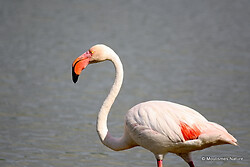
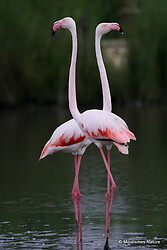
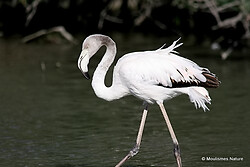
BIRDS
Total (both trips) = 122
Little Grebe Tachybaptus ruficollis
Great Crested Grebe Podiceps cristatus
Black-necked Grebe Podiceps nigricollis
Great Cormorant Phalacrocorax carbo
Little Bittern Ixobrychus minutus
Night Heron Nycticorax nycticorax
Cattle Egret Bubulcus ibis
Squacco Heron Ardeola ralloides
Little Egret Egretta garzetta
Great Egret Egretta alba
Grey Heron Ardea cinerea
Purple Heron Ardea purpurea
White Stork Ciconia ciconia
Eurasian Spoonbill Platalea leucorodia
Glossy Ibis Plegadis falcinellus
Sacred Ibis Threskiornis aethiopicus - 1 over Parc Ornithologique 6/2008
Greater Flamingo Phoenicopterus ruber
Mute Swan Gygnus columbianus
Greylag Goose Anser anser - feral
Shelduck Tadorna tadorna
Mallard Anas platyrhynchos
Shoveler Anas clypeata
Pochard Aythya ferina
Red-crested Pochard Netta rufina
European Honey Buzzard Pernis apivorus
Black Kite Milvus migrans
Short-toed Eagle Circaetus gallicus
Bonelli’s Eagle Hieraaetus fasciatus - 1 juvenile La Caume 6/2008
Marsh Harrier Circus aeruginosus
Buzzard Buteo buteo
Kestrel Falco tinnunculus
Lesser Kestrel Falco naumanni
Eurasian Hobby Falco subbuteo
Red-legged Partridge Alectoris rufa
Quail Coturnix coturnix
Pheasant Phasianus colchicus
Moorhen Gallinula chloropus
Coot Fulica atra
Black-winged Stilt Himantopus himantopus
Avocet Recurvirostra avosetta
Stone-curlew Burhinus oedicnemus
Collared Pratincole Glareola pratincola
Little Ringed Plover Charadrius dubius
Kentish Plover Charadrius alexandrinus
Lapwing Vanellus vanellus
Dunlin Calidris alpina
Whimbrel Numenius phaeopus
Eurasian Curlew Numenius arquata
Spotted Redshank Tringa erythropus
Common Redshank Tringa totanus
Green Sandpiper Tringa ochropus
Wood Sandpiper Tringa glareola
Common Sandpiper Actitis hypoleucos
Mediterranean Gull Larus melanocephalus - Breeding colony, Parc Ornithologique
Little Gull Larus minutus
Black-headed Gull Larus ridibundus
Slender-billed Gull Larus genei
Yellow-legged Gull Larus michahellis
Little Tern Sterna albifrons - Breeding colony Parc Ornithologique
Gull-billed Tern Sterna nilotica
Caspian Tern Hydroprogne caspia
Black Tern Chlidonias niger
Whiskered Tern Chlidonias hybridus
Sandwich Tern Sterna sandvicensis
Common Tern Sterna hirundo
Wood Pigeon Columba palumbus
Collared Dove Streptopelia decaocto
Turtle Dove Streptopelia turtur
Cuckoo Cuculus canorus
Eurasian Eagle Owl Bubo bubo
Nightjar Caprimulgus europaeus
Swift Apus apus
Alpine Swift Apus melba
Kingfisher Alcedo atthis
Bee-eater Merops apiaster
Roller Coracias garrulus
Hoopoe Upupa epops
Green Woodpecker Picus viridis
Great Spotted Woodpecker Dendrocopos major
Calandra Lark Melanocorypha calandra
Skylark Alauda arvensis
Crested Lark Galerida cristata
Woodlark Lullula arborea
Sand Martin Riparia riparia
Crag Martin Ptyonoprogne rupestris
Swallow Hirundo rustica
Common House Martin Delichon urbicum
Tawny Pipit Anthus campestris
Yellow Wagtail Motacilla flava
Nightingale Luscinia megarhynchos
Black Redstart Phoenicurus ochruros
Stonechat Saxicola torquata
Blue Rock Thrush Monticola solitarius
Blackbird Turdus merula
Sedge Warbler Acrocephalus schoenobaenus
Zitting Cisticola Cisticola juncidis
Cetti's Warbler Cettia cetti
Reed Warbler Acrocephelus scirpaceus
Great Reed Warbler Acrocephalus arundinaceus
Melodious Warbler Hypolais polyglotta
Blackcap Sylvia atricapilla
Sardinian Warbler Sylvia melanocephala
Common Chiffchaff Phylloscopus collybita
Long-tailed Tit Aegithalos caudatus
Crested Tit Parus cristatus
Great Tit Parus major
Short-toed Treecreeper Certhia brachydactyla
Jay Garrulus glandarius
Magpie Pica pica
Jackdaw Corvus monedula
Carrion Crow Corvus corone corone
Starling Sturnus vulgaris
Golden Oriole Oriolus oriolus
House Sparrow Passer domesticus
Eurasian Tree Sparrow Passer montanus
Chaffinch Fringilla coelebs
Goldfinch Carduelis carduelis
Greenfinch Carduelis chloris
Linnet Carduelis cannabina
Serin Serinus serinus
Cirl Bunting Emberiza cirlus
Corn Bunting Miliaria calandra

Spotted Darter (Sympetrum depressiusculum) male
France; Camargue in summer GALLERY
This report 14 - 21/6/2008. In July 2014 I co-lead a Birds/Dragonflies Camargue tour for Naturetrek. Those species have been added to the lists here, as the sites were much the same. The emphasis on that tour was obviously as much on birds as odonata.
Inspired by Jacquie Crozier’s book and research of websites covering nature reserves in the area (see Reference Sources), we decided to make base at a campsite near St-Martin-de-Crau. The Camargue is still one of the greatest wetlands in Western Europe, so a logical place to look for dragonflies and damselflies. In fact, we concentrated more on the Crau, an area with a growing reputation amongst odonata watchers, and did more birdwatching in the Camargue. We also visited the hills of Les Alpilles, north of La Crau, when too hot to walk the open areas.
In the varied habitats of the Camargue, the Crau and associated marshes, and Les Alpilles, 61+ species of odonata have been recorded.
The Camargue Regional Park south of Arles lies between the two arms of the Rhone as it forms a delta and enters the Mediterranean Sea. The Park covers 850 square kilometres and has the variety of habitats one would expect, including rice paddies and saltworks, saline, brackish and freshwater lagoons.
The Crau, with its’ unique stony desert landscape and bizarre weather, is well-known to birders because of the specialist breeding birds. The areas we visited here were all within 20 kilometres and to the south of St-Martin-de-Crau.
Les Alpilles are a chain of rugged limestone hills c28 kilometres long, covered in pine forest and garrigue, the highest point being just 493 metres.
We also checked areas local to our campsite at Mouries, nine kilometres north-east of St-Martin, mainly at points along the Canal de la Vallee des Baux, west of Mouries.
The weather was cool, 12-15 degrees and very wet for the first three days, quickly turning to a stifling 34+ degrees and dry for the remainder, this apparently being more normal for mid-June, but too hot to look for odonata by midday. The Camargues’ reputation for mosquitoes proved totally valid in wet weather, exceeding both in numbers and persistence anything we’ve encountered elsewhere in the world !
We made no attempt to see the specialist breeding birds of the Crau, the birds recorded were those seen whilst looking for odonata species; in the Camargue we did more birdwatching, depending on the weather or lack of dragonflies.
The timing here was at least a week too early for the maximum odonata species, particularly in a ‘late’ year – the last week in June would be good, after that the temperatures would be very hot, with more tourists and more traffic. The Camargue is a busy tourist area.
SITES VISITED
Peau de Meau Reserve, La Crau
Peau de Meau is well-known to birders looking for the Crau specialities. A permit is needed here, obtainable from Ecomusee de La Crau, on a corner in the main high street in St-Martin. Price at the time was 3 Euros per person for 2 days, proceeds going towards upkeep and improvement of the reserve. The trail and information boards have just been upgraded, and you get a map and info, in English, with the permit.
The Peau de Meau stream is the area of prime interest here for dragonfly watchers, it runs from the parking area in a straight line south-west towards the main highway N 568. Although it looks fairly mundane, the rich vegetation on the banks and below the water, and the purity and steady flow make for an abundance of odonata; around 50 species have been recorded here.
Etang des Aulnes, La Crau
Known to birders en route to Peau de Meau as a site of little interest, we saw few birds here either. About 1.5 kilometres south of La Dynamite and the junction with the D24, along the approach road to Peau de Meau, there is parking and an information board.
For dragonflies, we found the best area to be the course fishing zone, sign-posted on the road. Here there are three fishponds with a high density of odonata – we saw 15+ species in less than two hours.
Vigueirat Marshes, south of La Crau
A wetland reserve on the south-west side of La Crau, with a nice 2km trail through reedbeds, swamp forest and fields. The reserve centre is 2kms south-east of Mas Thibert, a few kms west of Peau de Meau, and is sign-posted from the town. Access to the core part of the marsh is by guided tour only, on a horse-drawn carriage ! We did the trail, but I suspect the best habitat is the central area.
Disappointing density of dragonflies seen, perhaps better after dryer conditions; a key site that we should have seen more at. Very good for mosquitoes…
Canal de la Vallee des Baux, north of La Crau
The Vallee des Baux lies between Les Alpilles to the north and La Crau to the south, with the canal running east-west along the valley. We checked road bridges over the canal, particularly the D33 and D27, both quite good for odonata, and found a ruined roman aqueduct south of Fontvieille on the D33 to be good also.
Parc Ornithologique, La Camargue
4 kilometres north of Saintes-Maries-de-la-Mer, the first part of the park is a bird hospital/recovery centre with victims of the ‘hunters’ guns, and the traffic, in large aviaries, mostly raptors and owls. After that there are good freshwater and brackish lagoons along a 7 kilometre trail. Probably good for dragonflies without the rain that we had.
Etang du Charnier and Etang de Scamandre, La Camargue
In the north-west Camargue, we looked at two freshwater etangs and the Sete canal. Route D779 runs NW – SE between the two etangs, and at the junction with D179 to the south there is a small reserve with trail and visitor centre. Along the south bank of the Sete canal is a drivable track giving views over Etang du Charnier. Good area for freshwater birds and some odonata species. The reserve looked good and deserved more time than we could give it.
We also drove down to the coast on routes D36 B, C and D, along the east side of the Etang de Vaccares and the Digue – all well-known birding sites amply covered by books and birding trip reports.
The Camargue has the largest Greater Flamingo population in Europe, c50,000 birds, and all the European herons breed there, the latest being Great White Egret. On the down side, this being France 150,000 ducks are shot each year….
Les Alpilles
La Caume is a communication station east of Les Baux, on the east side of route D5, where there is parking and the start of a track towards the summit. Well-known to birders looking for Bonelli's Eagle, etc, by the time of our visit there was no flowing water, so it produced little in the way of dragonflies.
REFERENCE SOURCES
A Birdwatching Guide to France South of the Loire. J. Crozier, Arlequin Press, 2000.
Vigueirat Marshes website
Conservatoire du littoral
Ecomusee de la Crau
Parc Ornithologique
Camargue Regional Park



SPECIES RECORDED; DRAGONFLIES AND DAMSELFLIES
Main source of reference - Field Guide to the Dragonflies of Britain and Europe. Dijkstra/Lewington, BWP 2006.
30 species seen. A poor total, I believe 35+ is possible even in mid-June, although probably too early for Orange-spotted Emerald Oxygastra curtisii, or Dusk Hawker Boyeria irene, definitely too early for Banded Darter Sympetrum pedemontanum (all three seen July 2014). The migratory Vagrant Emperor Anax ephippiger is described by Dijkstra as ‘uncommon, scattered and/or irregular’ throughout the Mediterranean.
Worst ‘miss’ was Yellow-tailed Demoiselle Calopteryx xanthostoma at Peau de Meau, a site known for holding all the European demoiselles. Dijkstra states that this species replaces C. splendens in southern France, we found and photographed only C. splendens.
The variety of blue damselfly species seen, two, was disappointing, and Scarce Blue-tailed Ischnura pumilio, must be here somewhere. Perhaps more time should have been spent at Etang des Aulnes
Total (both trips) = 36. Extra species July 2014 added in blue
BANDED DEMOISELLE Calopteryx splendens – Peau de Meau, Vallee des Baux, etc
BEAUTIFUL DEMOISELLE Calopteryx virgo – Peau de Meau only
COPPER DEMOISELLE Calopteryx haemorrhoidalis – Peau de Meau only
WILLOW EMERALD Lestes veridis – Etang des Aulnes
WINTER DAMSELFLY Sympecma fusca – Vigueirat marshes, Etang des Aulnes
BLUE-TAILED DAMSELFLY Ischnura elegans – recorded throughout
AZURE DAMSELFLY Coenagrion puella – Vigueirat marshes
SOUTHERN DAMSELFLY Coenagrion mercuriale – Peau de Meau, the only ‘blue’ found there
SMALL RED-EYED DAMSELFLY Erythromma viridulum – Vigueirat marshes, Etang des Aulnes, where hundreds 'in cop'
GOBLET-MARKED DAMSELFLY Erythromma lindenii – Vigueirat marshes, Etang des Aulnes fishponds, hundreds on each
SMALL RED DAMSELFLY Ceriagrion tenellum – Peau de Meau
ORANGE WHITE-LEGGED DAMSELFLY Platycnemis acutipennis – Vallee des Baux, Vigueirat marshes, Etang des Aulnes
WHITE FEATHERLEG Platycnemis latipes – recorded throughout
MIGRANT HAWKER Aeshna mixta – 6+ Les Alpilles, La Caume
GREEN-EYED HAWKER Aeshna isosceles – 2 Peau de Meau, 2 males Etang des Aulnes
EMPEROR Anax imperator – recorded throughout Camargue and Crau
LESSER EMPEROR Anax parthenope – 2 over rice paddies, 2 females Etang du Charnier, c4 Etang des Aulnes fishponds
DUSK HAWKER Boyeria irene - 2 males 13/7/14 Ntrek tour
PRONGED CLUBTAIL Gomphus graslinii - 11+ males 11/7/14, 15/7/14 N'trek tour
YELLOW CLUBTAIL Gomphus simillimus – 1 male, 1 female Peau de Meau
WESTERN CLUBTAIL Gomphus pulchellus – 1 male Vallee des Baux
BLUE-EYED HOOKTAIL Onychogomphus uncatus – recorded at all flowing water sites
GOLDEN-RINGED DRAGONFLY Cordulegaster boltonii - 1 male 1 female Ntrek tour 13/7/14
ORANGE-SPOTTED EMERALD Oxygastra curtisii - 1 male 12/7/14, 1 male 15/7/14 Ntrek tour
SCARCE CHASER Libellula fulva – Peau de Meau, Etang des Aulnes
BLACK-TAILED SKIMMER Orthetrum cancellatum – recorded throughout
WHITE-TAILED SKIMMER Orthetrum albistylum – Vigueirat marshes, Etang des Aulnes
KEELED SKIMMER Orthetrum coerulescens – Peau de Meau
SOUTHERN SKIMMER Orthetrum brunneum – Vallee des Baux roman aqueduct site, max. 6
BANDED DARTER Sympetrum pedemontanum - 8+ 15/7/14 Ntrek tour
RUDDY DARTER Sympetrum sanguineum – common later in the week, freshwater marshes
SPOTTED DARTER Sympetrum depressiusculum - 6+ 13/7/14, 15/7/14 Ntrek tour
RED-VEINED DARTER Sympetrum fonscolombii – 2 imm/females Vigueirat marshes only
COMMON DARTER Sympetrum striolatum – started to appear later in week, inc. Les Alpilles
SOUTHERN DARTER Sympetrum meridionale – Etang de Scamandra area, common at Etang des Aulnes fishponds by 21st June
SCARLET DARTER Crocothemis erythraea – recorded freshwater sites throughout
BUTTERFLIES
Total (both trips) = 33
SMALL SKIPPER Thymelicus lineolus
SWALLOWTAIL Papilio machaon
SCARCE SWALLOWTAIL Iphiclides podalirius
CLOUDED YELLOW Colius crocea
LARGE WHITE Pieris brassicae
GREEN-VEINED WHITE Pieris napi
SMALL WHITE Pieris rapae
BATH WHITE Pontia daplidice – fairly common Peau de Meau
WOOD WHITE Leptidea sinapis
LESSER PURPLE EMPEROR Apatura ilia
PURPLE HAIRSTREAK Neozephyrus quercus
BLUE-SPOT HAIRSTREAK Satyrium spini – only Les Alpilles, La Caume, where common
FALSE ILEX HAIRSTREAK Nordmannia esculi – common in lightly wooded areas
SMALL COPPER Lycaena phlaeas
GERANIUM BRONZE Cacyreus marshalli
SHORT-TAILED BLUE Everes argiades
LANG'S SHORT-TAILED BLUE Leptotes pirithous
HOLLY BLUE Celastrina argiolus
MAZARINE BLUE Cyaniris semiargus – Etang des Aulnes
COMMON BLUE Polyommatus icarus
COMMA Polygonia c-album
PAINTED LADY Vanessa virginiensis
RED ADMIRAL Vanessa atalanta
GLANVILLE FRITILLARY Melitaea cinxia
SPOTTED FRITILLARY Melitaea didyma
WALL BROWN Lasiommata megera
MEADOW BROWN Maniola jurtina
MARBLED WHITE Melanargia galanthia
SMALL HEATH Coenonympha pamphilus
SPECKLED WOOD Pararge aegeria
GREAT BANDED GRAYLING Brintesia circe – Vigueirat marshes
STRIPED GRAYLING Hipparchia fidia
SOUTHERN GATEKEEPER Pyronia cecilia
ORCHIDS
BEE ORCHID Ophrys apifera - 4-5 at Etang des Aulnes
WOODCOCK ORCHID Ophrys scolopax
LATE SPIDER ORCHID Ophrys fuciflora
LIZARD ORCHID Himantoglossum hircinum – c30 Parc Ornithologique



BIRDS
Total (both trips) = 122
Little Grebe Tachybaptus ruficollis
Great Crested Grebe Podiceps cristatus
Black-necked Grebe Podiceps nigricollis
Great Cormorant Phalacrocorax carbo
Little Bittern Ixobrychus minutus
Night Heron Nycticorax nycticorax
Cattle Egret Bubulcus ibis
Squacco Heron Ardeola ralloides
Little Egret Egretta garzetta
Great Egret Egretta alba
Grey Heron Ardea cinerea
Purple Heron Ardea purpurea
White Stork Ciconia ciconia
Eurasian Spoonbill Platalea leucorodia
Glossy Ibis Plegadis falcinellus
Sacred Ibis Threskiornis aethiopicus - 1 over Parc Ornithologique 6/2008
Greater Flamingo Phoenicopterus ruber
Mute Swan Gygnus columbianus
Greylag Goose Anser anser - feral
Shelduck Tadorna tadorna
Mallard Anas platyrhynchos
Shoveler Anas clypeata
Pochard Aythya ferina
Red-crested Pochard Netta rufina
European Honey Buzzard Pernis apivorus
Black Kite Milvus migrans
Short-toed Eagle Circaetus gallicus
Bonelli’s Eagle Hieraaetus fasciatus - 1 juvenile La Caume 6/2008
Marsh Harrier Circus aeruginosus
Buzzard Buteo buteo
Kestrel Falco tinnunculus
Lesser Kestrel Falco naumanni
Eurasian Hobby Falco subbuteo
Red-legged Partridge Alectoris rufa
Quail Coturnix coturnix
Pheasant Phasianus colchicus
Moorhen Gallinula chloropus
Coot Fulica atra
Black-winged Stilt Himantopus himantopus
Avocet Recurvirostra avosetta
Stone-curlew Burhinus oedicnemus
Collared Pratincole Glareola pratincola
Little Ringed Plover Charadrius dubius
Kentish Plover Charadrius alexandrinus
Lapwing Vanellus vanellus
Dunlin Calidris alpina
Whimbrel Numenius phaeopus
Eurasian Curlew Numenius arquata
Spotted Redshank Tringa erythropus
Common Redshank Tringa totanus
Green Sandpiper Tringa ochropus
Wood Sandpiper Tringa glareola
Common Sandpiper Actitis hypoleucos
Mediterranean Gull Larus melanocephalus - Breeding colony, Parc Ornithologique
Little Gull Larus minutus
Black-headed Gull Larus ridibundus
Slender-billed Gull Larus genei
Yellow-legged Gull Larus michahellis
Little Tern Sterna albifrons - Breeding colony Parc Ornithologique
Gull-billed Tern Sterna nilotica
Caspian Tern Hydroprogne caspia
Black Tern Chlidonias niger
Whiskered Tern Chlidonias hybridus
Sandwich Tern Sterna sandvicensis
Common Tern Sterna hirundo
Wood Pigeon Columba palumbus
Collared Dove Streptopelia decaocto
Turtle Dove Streptopelia turtur
Cuckoo Cuculus canorus
Eurasian Eagle Owl Bubo bubo
Nightjar Caprimulgus europaeus
Swift Apus apus
Alpine Swift Apus melba
Kingfisher Alcedo atthis
Bee-eater Merops apiaster
Roller Coracias garrulus
Hoopoe Upupa epops
Green Woodpecker Picus viridis
Great Spotted Woodpecker Dendrocopos major
Calandra Lark Melanocorypha calandra
Skylark Alauda arvensis
Crested Lark Galerida cristata
Woodlark Lullula arborea
Sand Martin Riparia riparia
Crag Martin Ptyonoprogne rupestris
Swallow Hirundo rustica
Common House Martin Delichon urbicum
Tawny Pipit Anthus campestris
Yellow Wagtail Motacilla flava
Nightingale Luscinia megarhynchos
Black Redstart Phoenicurus ochruros
Stonechat Saxicola torquata
Blue Rock Thrush Monticola solitarius
Blackbird Turdus merula
Sedge Warbler Acrocephalus schoenobaenus
Zitting Cisticola Cisticola juncidis
Cetti's Warbler Cettia cetti
Reed Warbler Acrocephelus scirpaceus
Great Reed Warbler Acrocephalus arundinaceus
Melodious Warbler Hypolais polyglotta
Blackcap Sylvia atricapilla
Sardinian Warbler Sylvia melanocephala
Common Chiffchaff Phylloscopus collybita
Long-tailed Tit Aegithalos caudatus
Crested Tit Parus cristatus
Great Tit Parus major
Short-toed Treecreeper Certhia brachydactyla
Jay Garrulus glandarius
Magpie Pica pica
Jackdaw Corvus monedula
Carrion Crow Corvus corone corone
Starling Sturnus vulgaris
Golden Oriole Oriolus oriolus
House Sparrow Passer domesticus
Eurasian Tree Sparrow Passer montanus
Chaffinch Fringilla coelebs
Goldfinch Carduelis carduelis
Greenfinch Carduelis chloris
Linnet Carduelis cannabina
Serin Serinus serinus
Cirl Bunting Emberiza cirlus
Corn Bunting Miliaria calandra